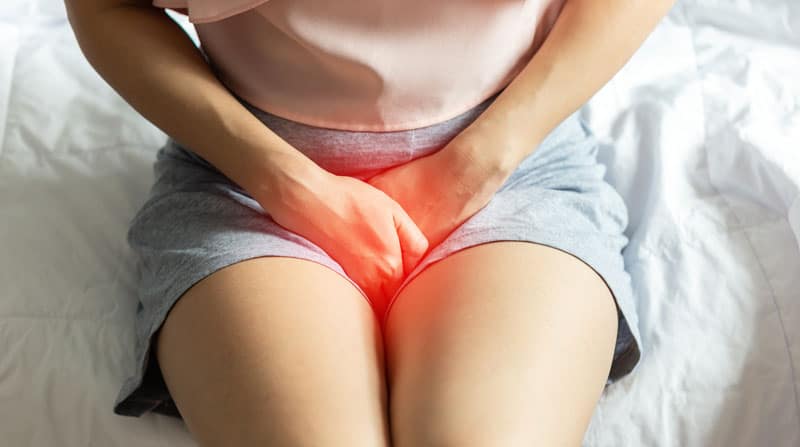What is female urinary incontinence?
Have you ever leaked out urine when you laughed or sneezed, coughed, picked up something heavy or during exercise?
When that happens, do you feel embarrassed and have to resort to wearing sanitary napkins or dark clothing, planning trips around restroom facilities, even sticking closer to home – just to shield yourself from embarrassment?
If you have, you may be struggling with symptoms of a common condition called urinary incontinence. Bladder leaks are a surprisingly common occurrence. About 45% of women have some degree of urinary incontinence.
Urinary incontinence can also be a symptom of other pelvic health issues, like pelvic organ prolapse (POP), a condition in which organs in the pelvic region shift out of their normal position.
What are the types of urinary incontinence?
There are 4 types of urinary incontinence that are most common in women:
- Stress Urinary Incontinence (SUI):
- You leak out urine involuntarily during sudden movements like coughing, sneezing, laughing, and exercising.
- Mixed Incontinence:
- This occurs when you have symptoms of both stress and urge incontinence.
- Urge Incontinence:
- You feel the sudden, intense urge to urinate, followed by bladder leakage. You may feel like you never get to the bathroom fast enough, or you may wake up several times a night with a strong urge to urinate.
- Overflow Incontinence:
- The bladder doesn???t completely empty due to dysfunctional nerves or a blockage in the urethra that prevents urine flow.
Stress Urinary Incontinence
Stress urinary incontinence (SUI) is a common, treatable condition in which sudden movements put stress on the bladder, causing urine to leak out involuntarily.
Stress urinary incontinence is one of the most common types of urinary incontinence among women. Because bladder leakage can be embarrassing, many women don’t talk about SUI or realize how common it is.
You may have stress urinary incontinence if you’ve leaked out urine involuntarily while:
- Laughing
- Sneezing
- Jumping
- Standing up or lying down
- Lifting something heavy
- Exercising
What causes stress urinary incontinence?
Stress urinary incontinence occurs when pelvic muscles supporting the bladder and urethra have been damaged or weakened, so that they may not hold the urethra in its correct position. Sudden movements from the diaphragm put stress on the bladder, causing the urethra to lose its seal and allowing urine to leak out.
Am I at risk of having stress urinary incontinence?
You are at risk of having stress urinary incontinence if you have the following:
- Pregnancy and childbirth
- Frequent heavy lifting
- Estrogen deficiency or menopause
- Obesity
Is my stress urinary incontinence treatable?
Many women assume stress urinary incontinence is just a natural part of aging or an inevitable consequence of having children. Misconceptions like these prevent many women from getting the treatment that is readily available and they deserve.
Consider this:
- About 1 in 3 women suffers from stress urinary incontinence
- Over 50% of women with stress urinary incontinence have never mentioned it to their doctor
Why keep planning your life around bladder leakage if you don’t have to?
What are the treatment options for my stress urinary incontinence?
Stress urinary incontinence (SUI) is treatable at any age, but not all approaches work for every person or for every type of urinary incontinence. There are a variety of treatment options.
Non-surgical treatment options
Behavioral / Muscle Therapy: Therapy often starts with Kegel exercises to help strengthen the pelvic floor muscles. Depending on the severity of your condition, however, Kegels may not bring sufficient relief.
Biofeedback: In this method, you exercise the pelvic floor muscles while connected to an electrical sensing device. The device provides feedback to help you learn how to better control these muscles. Overtime, biofeedback can help you use your pelvic muscles to decrease sudden urges to urinate and lessen certain types of pelvic pain.
Electrical stimulation: This approach aids pelvic floor exercises by isolating the muscles involved for extra stimulus.
Surgical treatment
While mild symptoms of urinary incontinence may be treated using the non-surgical treatments, women with more serious symptoms or conditions may respond better to a surgical procedure.
Today’s minimally invasive options mean you may be able to treat urinary incontinence with a simple outpatient procedure. In one type of treatment, your surgeon inserts a tape-like strip of mesh through very small incisions in the abdomen or vagina to support the urethra. The mesh acts as a supportive sling, allowing the urethra to stay closed when appropriate.
Be sure to talk to your doctor about the treatment options that will be suitable for you.

